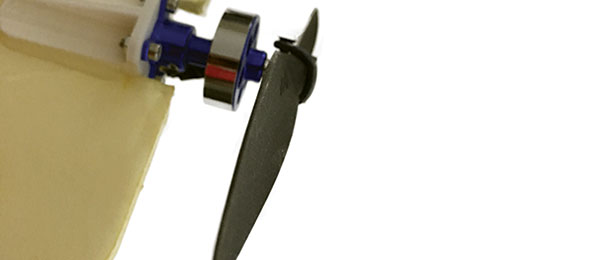
Written by Matt Ruddick Putting safety in the hands of everyone Guest Column As seen in the Winter 2018 issue of Park Pilot

Motors featuring the new POPO Quick Swap system share the same form factor as standard motors, except for a newly designed shaft.
When I first began building quadcopters, a few key things were ingrained in my mind when it came to safety. The first was to not leave batteries to charge unattended. The second was to use a multimeter before powering up the first time. And the third was to always remove the propellers when working on the bench. I want to focus on that last piece of advice for a moment because I have seen many posts on the internet made by pilots who chose to skip that part and ended up with some gnarly injuries to show for it. In many cases, these people felt that they knew what they were doing and were confident nothing could go wrong. Many of us can become complacent and occasionally have that same mindset. This is especially true when you only need to make a quick adjustment in the flight controller software. What harm could there be in plugging in, quickly making a PID (proportional integral derivative) change, and disconnecting? As we’ve seen, much harm can be done. One prominent company has stepped up to help solve this problem, and do it in a way that makes changing propellers lightning fast. Lumenier (lumenier.com) has launched its POPO (Pop On, Pop Off) Quick Swap system (priced at $26.99) that promises to allow pilots to install and remove propellers in seconds. This is not only a huge boon for drone racers who are under time constraints in between heats, but it makes removing a propeller during a repair a much more convenient procedure, and one that will hopefully result in far fewer injuries. The way this system works is simple. First, you’ll need a motor and propeller that is POPO compatible. Lumenier has been producing all of its propellers as POPO compatible for more than a year, so there are plenty out there from which to choose. What makes them compatible is the hub, which uses a special mold that allows the locking mechanism from the motor shaft to engage.

Even under typical flying conditions, the POPO system held up without any signs of failure.
The motors use a push-button, quick-release mechanism in the propeller shaft to lock and unlock the propeller from the motor. By simply pressing down on the button as you slide the propeller onto the motor then turning the propeller, you’ll hear and feel a click. That’s when you know the propeller is locked and ready to go. To remove it, simply press the quick-release button and pull off the propeller.

The POPO system survived normal crash scenarios without ejecting a single propeller.
Lumenier states that you can change out a full set of propellers in less than 30 seconds. My tests show that this statement is 100% correct—it is as easy as advertised. Of course, none of this will matter if the system can’t hold up to the stresses of flying the way most of us typically do. Can it withstand impacting gates on the racetrack? Can it withstand catching a tree branch? I had heard anecdotes that the motors were tested at some big-time race events earlier this spring, but without firsthand knowledge of that, I needed to do my own tests. The first motors to use this system were the Lumenier MX2206-9 2,450 Kv motors. I installed them on a Lumenier Nova frame with a FlightOne (flightone.com) FC and ESC stack. The motors performed as I would expect from a high-end Lumenier setup—smoothly and precisely. However, I was much more interested in durability testing with this system, so I did something that you would normally avoid doing on purpose when flying one of these machines: crash. Crash testing this system was more challenging than I expected. As it turns out, ignoring my natural reflexes of avoiding obstacles was tough at first, but it finally came to me and I flew straight line after straight line through some tree branches to see if a propeller might fly off. To my surprise, each crash resulted in nothing more than a bent propeller or two, but all were still completely intact. A cartwheel across the ground resulted in the same thing. I finally put the Nova to the test on a racecourse to see how it would handle hitting a gate. Remarkably, it came back with all of the propellers still attached to their motor shafts, and the POPO system was still operational. At the time of this writing, the Lumenier motors are the only ones on the market using the POPO system, although companies such as Xhover (xhover.com), T-Motor (store-en.tmotor.com), and Emax (emax-usa.com) have already announced plans for POPO-compatible motors. Likewise, HQ and Gemfan have released POPO-compatible propellers, so it does appear as though other manufacturers are catching on to the potential benefits of this system and have invested in its success. At the end of the day, we’re looking at a system designed for convenience. There is nothing wrong with the old way of attaching propellers to motors by using a good, old-fashioned prop nut. In fact, POPO motors and propellers are backward compatible with standard motors and propellers and can be used with standard prop nuts as well. We’re looking at a way to make the hobby we enjoy safer by making things more convenient. The hope is that a pilot who thinks it takes far too much time to take a propeller off while he or she tunes a quadcopter might just think twice if it only takes 15 to 30 seconds to get it off. The POPO Quick Swap could just save him or her a trip to the emergency room for a new set of stitches.
Article:





